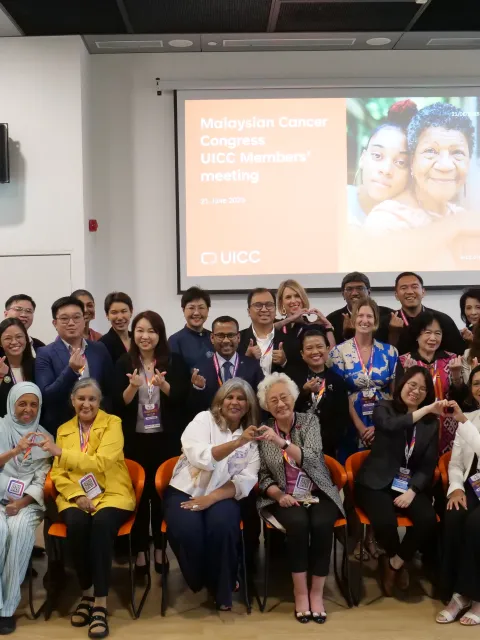Cancer care during COVID-19 in Malaysia: focusing on prevention and primary care
In an interview with UICC, Dr Adeeba Kamarulzaman, speaks of how the Faculty of Medicine at the University of Malaya managed the outbreak of COVID-19.

Dr Adeeba Kamarulzaman is Dean of the Faculty of Medicine and Professor of Medicine and Infectious Diseases at the University of Malaya, and last year she was appointed as the first Asian President of the International AIDS Society.
What challenges have your organisation, your staff, your services and the people you care for faced in the past year through COVID-19?
Thanks to our experience with the SARS epidemic in 2003, we acted very quickly as soon as we heard the news from China, as early as January. I called for the formation of a task force, which I chaired. We did a situation analysis, establishing priorities for preparedness. In February, we started cutting back on elective surgery so as not to place divert resources, such as anaesthetics, protective equipment and blood supplies, which were already dwindling as people were afraid to donate.
I then declared, despite pushback, that we would take COVID-19 patients and we reorganised the hospital so as to not mix patients. In parallel, we cut back on outpatient visits to reduce risks, while ensuring that patients were contacted and that medicines were delivered or posted or picked up, often in multi-month supplies. So ultimately we also became a COVID-19 hospital, but patients were efficiently treated and there were minimal in-hospital infections.
Non-emergency surgeries were suspended, as well as Programme Rose, our community-based screenings for HPV, but our cancer wards continued to operate, including day care for chemotherapy outpatients. Diagnostics and screenings were reduced, but not to a large extent because, at that time, the incidence of COVID-19 was nowhere near as high as the US or Europe.
When the third wave of the pandemic arrived at the end of last year, we were already more confident in handling patients and much more information was available. Operating theatres, radiotherapy, and other cancer services have continued even if the number of COVID-19 infections have been much higher.
What major changes or innovations enabled you to keep providing your services?
I’d say the move to telemedicine has been crucial, though that didn’t occur as fast as I would have wished, due to fears of personal data protection and regulatory issues. Also, we still need people to assist more vulnerable populations (e.g. the elderly) in using digital technologies, but older people here tend to have children or grandchildren who take care of them. There’s big family support here in Malaysia.
What long-term impact do you feel the pandemic might have on your services and on cancer control in your country? How can these additional challenges be addressed?
While we were well prepared for COVID-19, right now the government and the Ministry of Health remain engulfed and overwhelmed in its response to the pandemic.
Even before COVID-19 arrived, we were sounding the alarm that government authorities were not paying enough attention to primary care and preventative care – particularly cancer and AIDS where late diagnosis is the norm – in order to avoid later complications. Pap smears has gone down to 32%; when it comes to prostate cancer, 60% of people present late, at stages three and four; and breast cancer and colorectal cancer face similar situations of late diagnosis.
How would you or do you advocate for better funding in cancer care?
Governments only listen to dollars and numbers. If you show that late diagnoses mean more costly health expenditures, they might listen. Authorities also need to realise that a more effective financial response to economic devastation is to build up community-based interventions. Again, we must emphasise the need to focus more on prevention and primary care if we want to save lives and money.
Also, measures and interventions have to be developed and implemented within a solid framework. There needs to be monitoring and evaluation as well as training, for instance, so that primary physicians can identify cancers earlier.
Do you also see any “silver lining” in terms of innovations or addressing inequity or weakness in the health system that the pandemic has revealed?
Yes, I’d say an important silver lining of COVID-19 has been an expansion of primary care and home or community care.
Those working in the HIV space have had more experience with community-based engagement than those in the cancer space, and we have a lot of examples where peer-based and community-based programmes went out of their way to deliver preventive tools (condoms, syringes, opioid substation, prescriptions) for HIV. They also recognised that there may be interruptions with antiretroviral drugs and quickly mobilised to get several months supplies for those in need. We now need something similar for cancer in expanding the home delivery of medication and treatment.
I think we might also see an increased move towards patient-centred care. I’ve been discussing with my colleagues about renovating one of the buildings near the hospital and transform it into a cancer ward for more evidence-based cancer screening. But it should be gender-based and by cancer type, but rather age-based. We need to look at care from the perspective of the patient, not through the lens of our own predetermined silos.
Some in the cancer space have pointed to the success of the HIV community in sustaining funding for the disease, while cancer advocacy has been more fragmented. Could the two communities work together for mutual benefit, considering, for instance, that there are high incidences of cervical cancer among people living with HIV?
There are definitely opportunities to coordinate efforts between the two communities, particularly with respect to programmed integration and research collaboration between HPV [human papillomavirus] and HIV. We have become so specialised, when what we need to be doing is working across sectors and diseases.
Last update
Friday 15 January 2021
